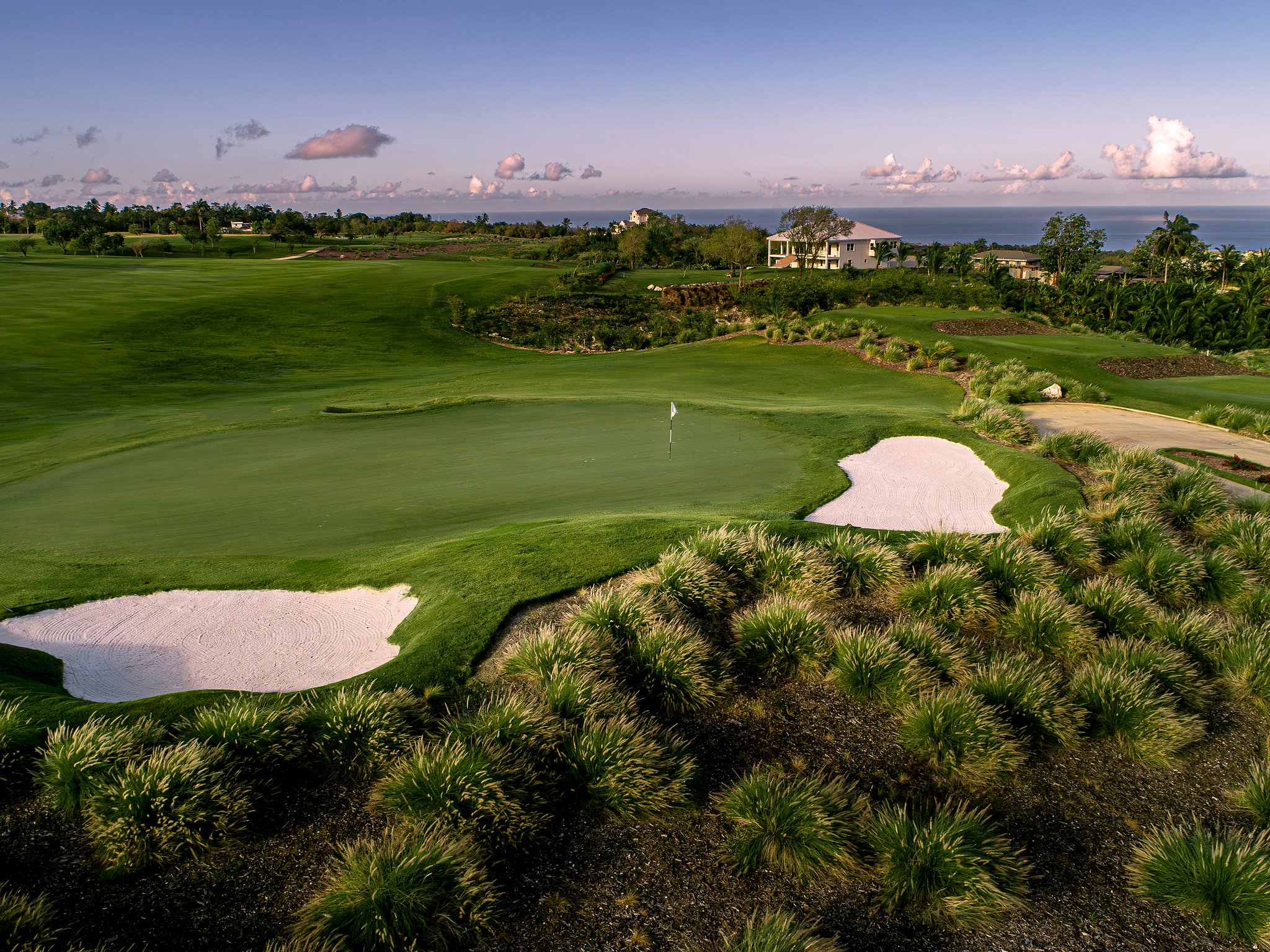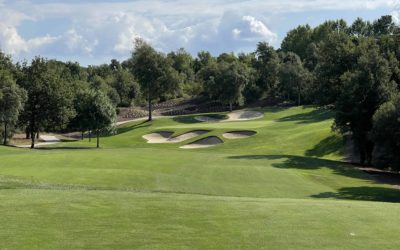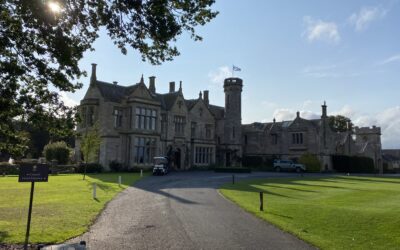Read time: 9 minutes (2,390 words)

It’s summer 2017, Dublin’s cobble streets are crawling with U2 t-shirts. Local lads done good, Bono and the boys are in town. They’ve sold out Croke Park, Ireland’s largest stadium where 80-000-plus gather for Gaelic football and hurling. A four-plane flyover paints an orange, white and green Irish flag smoke trail in the sky. Drummer Larry Mullen is first on the stage. He wears a shirt that reads “home” across the back. He sits down at his drum kit, smashes into his snare and the crowd goes wild — it’s “Sunday Bloody Sunday”. Lead guitarist “Edge” appears next, blue-shades-Bono strolls on singing and Adam Clayton on bass completes the band — Croke Park explodes like Shane Lowry just won The Open at Royal Portrush.

Bookending that legendary concert were rounds of golf on nine of the Green Isle’s most beloved links. No clubs needed, anyone would bask in a stroll on the fairways of The European Club or The Island Golf Club. Golf on these masterpieces is gravy on bangers and mash — the golf just makes it better. The terrain with its massive dunes, subtle bumps and moon-like craters is more beautiful than Sinéad O’Connor’s voice. The rugged and tough Irish Sea always looks good from the coast — it’s best coming up the par 5 thirteenth at The European Club.
I was a spoiled rotten golfer after my Irish links parade. Like picking a favorite U2 tune, it’s hard to choose a favorite, but I’d take The Island by a nose over The European Club. I feel awful for putting Portmarnock Old and County Louth in a backseat to any course, anywhere. I had the pleasure of playing with County Louth head professional Paddy McGuirk and god bless this man. His eagle eye found my castaway tee balls in waist-high fescue at least half a dozen times — a greater feat than the Golden Bear’s 18 majors.

Also a music journalist, the next leg was south and to the east. I hopped on a 5 a.m. Friday morning Ryanair flight from Dublin to Brussels to cover a three-day music festival in Boom, Belgium. The Tomorrowland festival exceeded the hype and I understand why it attracts 185,000 people from over 75 countries. I caught up with artists I like to write about: Roger Sanchez, Markus Schulz and Armin van Buuren. And I fraternized with like-minded music fans. There’s something about festival special moments that spawn lifelong friendships. I still keep up with people I met there from Russia, Australia and the USA motherland.

Nine rounds of golf and three days of festival proved exhausting. I found an Airbnb in the small Belgian village of Sint-Gillis-Waas to catch up on sleep and work. From Boom to the Airbnb was an Uber-train-bus journey of Christopher Columbus proportions. The local language in these parts is Flemish, a Dutch-French curve ball more confusing than airport signage. The sleep was heaven-sent — next on my agenda was a train ride to Liège, Belgium near the Germany border.
From Sint-Gillis-Waas to Liège was easy like mayonnaise on french fries. A new and improved Belgium savvy traveler, I stopped in Antwerp to look around Belgium’s second largest city. Their train station is one of my favorites in all of Europe to get lost in, and there are many. But I was anxious for Liège.
Near Liège’s city center, my new Airbnb hosts were sitting down for dinner when I arrived around 7 p.m. They spoke French and Arabic. My Arabic is worse than my Flemish, and my French is terrible, but it felt like my native language compared to the alternatives.
“Bonjour, je m’appelle Elvis,” felt so damn good.
They invited me to join for dinner and five of us enjoyed bowls of hearty beef soup. It didn’t take long for the questions to begin, “Who are you, where are you from and why are you in Liège?” They were shocked to learn I was American and pulled out a camcorder to record our conversation.

“I’m here to pay my respects to my great uncle, he died in World War II and is buried in an American cemetery south of here,” I butchered in Google translated French.
Then a man popped in the back door like a ninja as if he’d heard about a rare visitor from a faraway wonderland. He grabbed a bowl of soup and took a seat. He spoke F+ English and took over the interview-conversation. The camcorder was a bit odd, but dinner was a joy and we shared a few laughs. It’s those language wall moments and general discomfort that makes travel so special. After dinner I took a walk and got lost in Liège, something I’d become proficient at. A lot of the churches needed some TLC and a good scrub. Their style of neglect had surpassed charming — these cathedrals were deteriorating. They were covered in thick green algae, big ugly weeds and some even had small trees growing off the sides. I climbed all 374 stairs of the Bueren Mountain staircase, that’s 302 more than the “Rocky Steps” in Philly. Nine golf courses, three days of festival and 374 stairs proved exhausting.
Well rested at last, I woke early the next morning and hopped on a bus to the Ardennes American Cemetery and Memorial 10 miles south of my Airbnb. It’s about 20 minutes in a car and almost two hours on the city bus. I didn’t mind, the scenes of charming Belgian farms with cows and boutique gardens never gets old.

The bus dropped me off about a mile from the entrance — it proved to be the greatest little hike of my life. A large blue sign read, “American Military Cemetery 200m,” I was close. A quintessential Euro backpacker with just the clothes on my back and big pack, I stood at the gates of the tidy entrance with its shaped shrubs and fresh-cut grass. Engraved stone to the left read, “Ardennes American,” and to the right, “Cemetery and Memorial.” Its tall black wrought iron gates were open and a canopy road is the only way in or out.

My grandmother rarely fussed at granddad, but when she did, he was likely sneaking a cigarette. But their tiffs were more cute than malicious. They had a certified “Until death do us part,” marriage, and have the 57 anniversaries to prove it. I was only 18 when my grandmother passed and 20 when granddad went. A lot of fond memories were packed in those years — they went by too fast. My grandparents took me to the zoo, we played Uno, had the best holidays and enjoyed the best home-cooked meals. And I remember hearing my granddad talk about losing his brother in World War II. And I remember a few photos from the time in 1985 when my aunt took him to visit his brother’s grave in Belgium.
I’d always wanted to go there. And when it happened, the moment proved bigger than expected. Standing alone at the entrance to the cemetery where my great uncle was laid to rest and where my granddad had visited was a gulf of emotions. It was sad to think of the lives lost — more than 75 million people around the world died in WWII. My grandfather was only 26 when he lost his older brother by just two years, I often think about what that was like. And I can’t imagine what it was like for him to travel from Texas to Europe and visit his grave.
I walked into the cemetery and down the shaded road which is a lot like Magnolia Lane at Augusta National. It arrives at a magnificent whitebed limestone memorial building. On its face is a high relief carving of an American eagle. Bordering the building are granite tablets with the names of 462 that were never recovered. Surrounding the memorial are 5,329 white emblems-of-belief tombstones — there are a few Star of Davids, but mostly Christian Crosses like my uncle’s. It was easy to find the plot D, row 3 grave 48 white Lasa marble cross headstone. The only other person in the 90 acre cemetery was a man tossing fertilizer. He noticed my approach and quietly moved on.

Looking at the grave numbers, every one of them a casualty — grave 45, grave 46, grave 47 and there it was, grave 48. In embossed caps, “WILLIAM W. ANDERSON.” On the second line, “SGT 509 BOMB SQ 351 BOMB GP (H),” and the footer confirmed I was at the right place, “TEXAS SEPT 12, 1944.”
I stood at his grave, and sat at his grave for 30 minutes thinking about the ultimate sacrifice he made at such a young age. He’d recently turned 28, was married, had a baby boy and was from Montague County, Texas. I thought about how hard it must have been for my grandfather. The care and beauty of the grounds weighed on the experience. It was almost 60 years after the cemetery’s formal dedication and there wasn’t a weed in the place. There’s saying thanks, and then there’s building a museum-like cemetary and pruning it like a Bonsai tree for perpetuity. And beyond gratitude, the Ardennes American Cemetery and Memorial and the other 24 American cemeteries in foreign countries serve as reminders that never again should so many perish.
On the way out I stopped at the memorial building. I left my backpack at the door and went inside where there is a prayer altar and mosaic war maps with bronze lettering. Illustrated is the Allies’ west-to-east effort following the Invasion of Normandy in June 1944, which would take William W. Anderson’s life. I stood alone in the large room with polished marble walls.
Another gentleman in a uniform peaked in, and in a French accent asked in English, “This your backpack, sir?”
“Yes,” I replied.
“Just making sure, thank you. Sorry to disturb.”
I saw two men in the hour I was at the cemetery — one keeping it beautiful and the other making it safe. Outside the building is a bronze Jennewein Statue of “Youth”. It looks over the fallen, a reminder that those who died were in the prime of their life.
I walked out of the cemetery feeling like I’d been baptised. I found a cafe up the street — they’re pretty easy to find in Belgium. Over the best latte and chocolate croissant I’ve ever had, I took a moment to think about the experience. I remember sending a few photos and a text message to my aunt, the one that took my granddad there and all I could come up with was, “That was powerful.” Then I thought about what it was like for her to take her father there, stand there and watch him cry. We have these little wants in our head and some are louder than others. I’d answered one of those when I stood in the same place as my grandfather and celebrated a hero I never knew.
After all that, I was ready to go home. I flew back to Ireland a few days later to get my golf clubs and catch my flight back to the U.S. I was 37 at the time and it changed me — in a good way.
Dublin is a good place to burn a day. I didn’t play golf, my Irish links cupboard was full for the moment. An afternoon at a literature museum was a fairytale ending to the trip.

I walked in and was greeted by a smiling woman, “Welcome to the Dublin Writers Museum,” she said.
“Thanks for having me,” I replied.
“What brings ya to Dublin?”
“I’m a journalist and am looking for anything to do in Ireland besides golf and Guinness.”
“Oh great, good luck with that” she laughed, “And by the way, journalists are complimentary.”
My first thought was to Kool-Aid out of the museum and alert every bartender at every pub in Dublin of my journalistic gratis status, but I stayed. Irish authors only in this place, there’s a first edition of “Dracula” by Bram Stoker and a “Gulliver’s Travels” by Jonathan Swift from the 1700’s on display. Another Irishman, Oscar Wilde and his 1882 cavalier quote is on display, “I have nothing to declare except my genius.” I visited the hottest cathedrals in town, St. Patricks and Christ Church. But I’m partial to St. Michan’s Church and its 800 year old crypt with coffins and real mummies. For about 10 Euros, they offer a guided tour of the church’s basement. The tour guide man has loads of witty banter, like a lot of the folks in Ireland — they’re a wonderful group of people.

I’ve found that preflight and inflight announcements in Irish accents have a calming effect. Perhaps every airline should opt for the jovial tones from the Emerald Isle. The next morning I got comfortable in Aer Lingus’ coach section for the haul back to the States. With those soothing “fasten your seatbelt and use your oxygen mask as a snorkel” briefings I thought about the Ardennes American Cemetery. I’ll never forget the grace of the staff. Our interactions were brief, but just being there together implies a level of solidarity.
I wrote a note on the back of my bus ticket and left it for Uncle Welton, it read, “My grandfather told me stories about you. It’s an honor to be here. You’re one of my heroes.”
I wanted him to know.
I think my granddad was proud, and like I heard a thousand times, I could hear him say, “You’re a pretty good ol’ boy.”





 0
0









